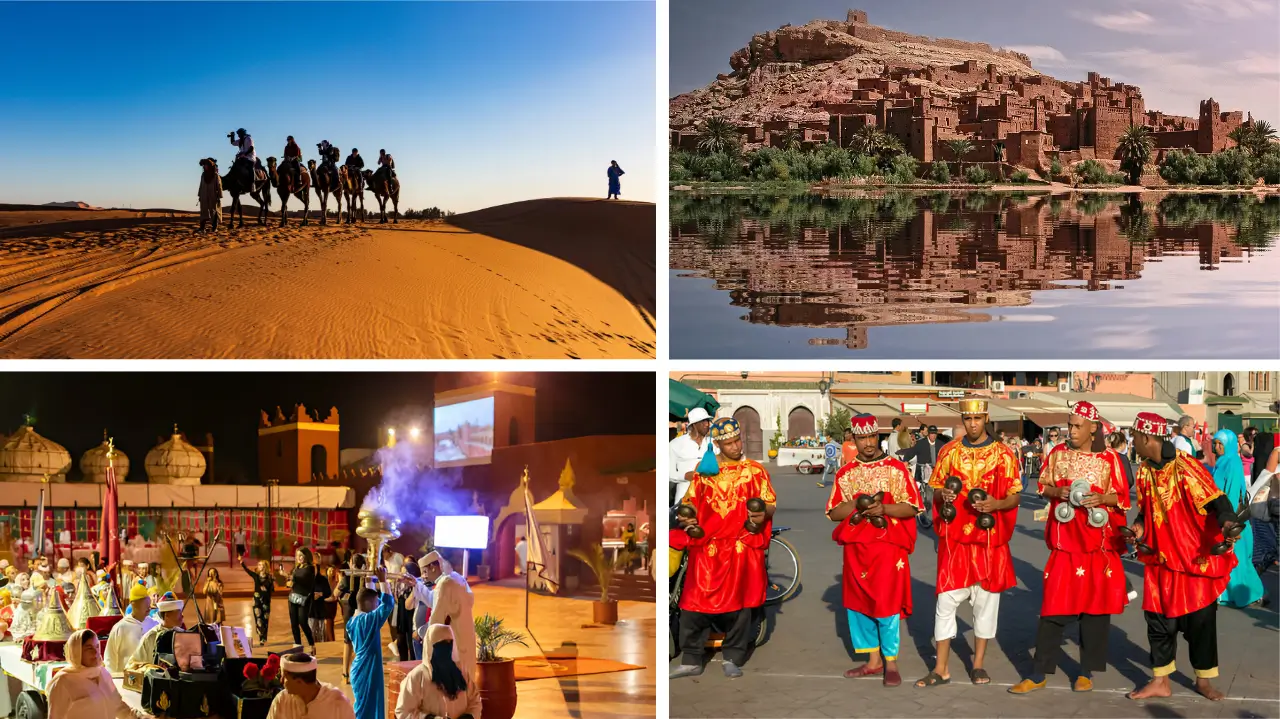Morocco travel guide

Morocco stands as a destination of remarkable contrasts and captivating beauty where ancient medinas and bustling souks exist alongside breathtaking mountain ranges and sprawling deserts.
This comprehensive travel guide aims to equip first-time visitors with everything they need to know before embarking on a Moroccan adventure, from planning essentials to cultural nuances that will enhance your journey.
Table of Contents
Planning Your Morocco Adventure
When to Go
Morocco has experienced a significant tourism boom, reflecting the growing global fascination with the country’s diverse landscapes and rich cultural heritage.
Best Seasons to Visit
- Spring (March-May): Pleasant climate, blooming flowers, accessible Atlas Mountains.
- Fall (September-November): Comfortable temperatures, fewer crowds, cooler desert.
- Winter (December-February): Mild coastal temperatures, cold mountains, ideal for city and desert exploration.
- Summer (June-August): Intense inland heat, comfortable coastal destinations like Essaouira.
Key Festivals Worth Planning Around
- Ramadan: Dates vary (lunar calendar). Be aware of altered business hours.
- Festival of World Sacred Music (June, Fes)
- Imilchil Marriage Festival (September)
- Marrakech International Film Festival (November/December)
Entry Requirements & Logistics
Visa Information
Most visitors from North America, Europe, Australia, and many other countries can enter Morocco visa-free for up to 90 days. Always check the latest requirements with your country’s foreign services department or the Moroccan consulate before traveling Link to US travel advice.
Getting There
- Mohammed V International Airport (Casablanca)
- Marrakech Menara Airport
- Fes-Saïss Airport
- Ferry services from Spain (Algeciras, Tarifa) to Tangier
Navigating Morocco: Transportation Guide
Between Cities
- Trains: Morocco’s rail network (ONCF) connects major cities. (oncf.ma) The high-speed Al Boraq line connects Tangier with Casablanca in just over 2 hours.
- CTM & Supratours Buses: Reliable intercity service. (ctm.ma and supratours.ma – *Replace with the correct Supratours URL*)
- Grand Taxis: Shared Mercedes sedans.
- Domestic Flights: Royal Air Maroc connects major cities. (royalairmaroc.com)
Within Cities
- Petit Taxis: Color-coded, metered taxis.
- Ride-hailing Apps: Careem and similar services.
- Walking: Best way to explore medinas.
Must-Visit Destinations in Morocco
Morocco boasts more UNESCO World Heritage sites than any other African country (nine total – whc.unesco.org/en/statesparties/ma), along with countless other cultural and natural wonders.
Imperial Cities
- Marrakech: The “Red City” with Jemaa el-Fnaa square, Koutoubia Mosque, Bahia Palace, and Jardin Majorelle.
- Fes: Fes el-Bali (car-free urban area), ancient tanneries, Al-Qarawiyyin university, and madrasas.
- Rabat: Kasbah des Oudaias, Hassan Tower, Royal Palace, and Chellah necropolis.
- Meknes: Bab Mansour, Heri es-Souani, and a less crowded medina.
Natural Wonders
- High Atlas Mountains: Hiking (including Mount Toubkal), Berber villages, and dramatic valleys.
- Sahara Desert: Camel treks, desert camps (Erg Chebbi, Erg Chigaga), and Berber nomadic culture.
- Atlantic Coast: Essaouira, Agadir, Taghazout, fresh seafood, and relaxed vibes.
Hidden Gems
- Chefchaouen: The “Blue City” with blue-washed buildings, a relaxed pace, and nearby hiking (Talassemtane National Park, Akchour waterfalls).
- Aït Benhaddou: An ancient fortified ksar (UNESCO site), film location, and example of earthen clay architecture.
- Ouarzazate: Gateway to the desert, home to film studios, and near Dadès and Todra Gorges, featuring Taourirt Kasbah.
Cultural Insights: Navigating Moroccan Society
Language Basics
- Arabic: The official language.
- Berber/Amazigh languages: Widely spoken in rural areas.
- French: Commonly used in business, government, and tourism.
- English: Increasingly common in tourist areas.
Useful phrases: “Salam alaikum” (Hello), “Shukran” (Thank you), “La shukran” (No thank you), “Afak” (Please).
Etiquette Tips
- Dress modestly (covering shoulders and knees is respectful).
- Remove shoes when entering homes or religious buildings.
- Ask permission before photographing people.
- Use your right hand for eating and greeting.
- Expect hospitality.
Final Thoughts
Morocco rewards travelers with a sensory feast of colors, flavors, sounds, and landscapes that few countries can match. Its position at the crossroads of African, Arab, and European influences has created a culture of dazzling diversity that explains its growing popularity as a destination.
Whether you’re haggling in ancient souks, sipping mint tea with locals, summiting a mountain peak, or watching the sunset paint Saharan dunes gold, Morocco offers experiences that will stay with you long after you’ve returned home. With thoughtful planning and cultural awareness, your journey through this remarkable country will surely become one of your most treasured travel memories.

One Comment